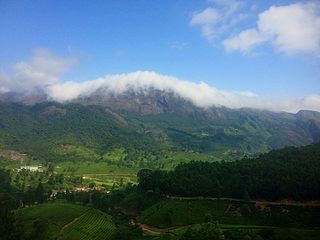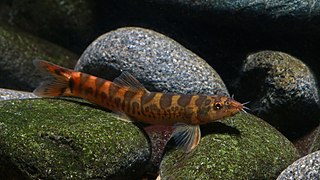
The Western Ghats, also known as the Sahyadri mountain range, is a mountain range that covers an area of 160,000 km2 (62,000 sq mi) in a stretch of 1,600 km (990 mi) parallel to the western coast of the Indian peninsula, traversing the states of Gujarat, Maharashtra, Goa, Karnataka, Kerala and Tamil Nadu. It is a UNESCO World Heritage Site and is one of the 36 biodiversity hotspots in the world. It is sometimes called the Great Escarpment of India. It contains a very large proportion of the country's flora and fauna, many of which are endemic to this region. The Western Ghats are older than the Himalayas. They influence Indian monsoon weather patterns by intercepting the rain-laden monsoon winds that sweep in from the south-west during late summer. The range runs north to south along the western edge of the Deccan Plateau and separates the plateau from a narrow coastal plain called the Western Coastal Plains along the Arabian Sea. A total of 39 areas in the Western Ghats, including national parks, wildlife sanctuaries and reserve forests, were designated as world heritage sites in 2012 – twenty in Kerala, ten in Karnataka, six in Tamil Nadu and four in Maharashtra.

The Malabar large-spotted civet, also known as the Malabar civet, is a viverrid endemic to the Western Ghats of India. It is listed as Critically Endangered on the IUCN Red List as the population is estimated to number fewer than 250 mature individuals. It has not been recorded during surveys carried out between 1990 and 2014. In the early 1990s, isolated populations still survived in less disturbed areas of South Malabar but were seriously threatened by habitat destruction and hunting outside protected areas.

The bare-bellied hedgehog, also known as the Madras hedgehog, is a species of hedgehog that is endemic to dry arid regions and scrubby jungles in southeastern India. As it was believed to be rare, it was formerly listed as Vulnerable by the IUCN. It is now known to be locally common in the Indian states of Andhra Pradesh and Tamil Nadu, resulting in its new listing as a species of Least Concern. Hedgehogs are protected species under schedule IV of Wildlife Protection Act (1972).

The melon barb is a common species of cyprinid fish that is endemic to rivers in Goa, Karnataka, Kerala and Tamil Nadu in the Western Ghats of South India. They live in a tropical climate in water that typically has a pH of 6.0—6.5, a water hardness of around 5 dGH, and a temperature range of 22–26 °C (72–79 °F). This species can also be found in the aquarium trade.

The Adan River is a river in Washim District, Maharashtra, India and a principal tributary of the Painganga River.

Osteobrama is a genus of cyprinid fish found in southern Asia consisting of eight species. The name is derived from the Greek word osteon, meaning "bone", and the Old French word breme, a type of freshwater fish.

The Kempholey night frog is a species of frog in the family Nyctibatrachidae.

The green chromide is a species of cichlid fish that is native to fresh and brackish water habitats in some parts in India such as Kerala, Goa, Chilika Lake in Odisha and Sri Lanka. The species was first described by Marcus Elieser Bloch in 1790. This species and other members of the genus Etroplus are relatively closely related to the Paretroplus cichlids from Madagascar.

Schistura semiarmata is a species of stone loach in the genus Schistura. It is found in the Indian states of Karnataka, Kerala, and Tamil Nadu and, at least based on some sources, in Pakistan. It grows to 5.6 cm (2.2 in) SL. It is a very common species inhabiting high altitude streams with hard bottom. It is sometimes used as an aquarium fish.

Mesonoemacheilus petrubanarescui is a species of ray-finned fish from India. The specific name petrubanaescui honours the Romanian ichthyologist Petre Mihai Bănărescu. It grows to 3.5 cm (1.4 in) standard length. It is endemic to the Western Ghats and is known from only two locations, the Netravati River and Kabani River in Karnataka and Kerala. It is a little known species which is rare and may be threatened by habitat alteration, sand mining and pollution. It turns up occasionally in the aquarium trade where it is sold as the "dwarf loach".

Osteobrama bakeri is a species of ray-finned fish in the genus Osteobrama. It is endemic to streams in the southern Western Ghats of Kerala where it has been recorded from the rivers Chaliyar ; Periyar, Chalakudy, Karuvannur, Muvattupuzha, Meenachil, Manimala, Chandragiri, Bharathapuzha, Pamba, Kallada and Achenkovil.

Osteobrama cotio is a species of ray-finned fish in the genus Osteobrama. This species had three subspecies named O. cotio cotio, O. cotio cunma and O. cotio peninsularis but these are now considered separate species. This species is found in the drainage basins of the Ganges-Brahmaputra including Jiri River in Manipur, Barak River in Silchar, in Brahmaputra River, Uzan Bazaar in Assam, and in Bihar, Madhya Pradesh, Uttar Pradesh, and Punjab in India, and in Bangladesh. The presence of O. cotio in southern India and from the Indus basin of India and Pakistan needs to be confirmed. This species is threatened by extensive loss of habitat caused by pollution and deforestation.

Osteobrama neilli is a species of ray-finned fish in the genus Osteobrama.

Osteobrama vigorsii is a species of ray-finned fish in the genus Osteobrama. It is known to occur in the states of Andhra Pradesh, Chhattisgarh, Karnataka, Madhya Pradesh, Maharashtra and Orissa in the drainage systems of the Krishna, Godavari and Mahanadi. It is found in fast flowing streams and rivers as well as reservoirs. It attains a total length of 30 cm and its prey is smaller fish and insects.

Calocypha laidlawi, or myristica sapphire, is a rare species of damselfly belonging to the family Chlorocyphidae. It is found only from Karnataka and Kerala in South India.

Disparoneura apicalis, black-tipped bambootail is a damselfly species in the family Platycnemididae. It is endemic to Western Ghats. It was described from Kodagu, Karnataka, on the upper reaches of the Kaveri River. It is also found to occur in Kuruvadweep, Wayanad, Kerala, along the banks of Kabini River.
Osteobrama cunma is a species of freshwater ray-finned fish from the carp and minnow family, the Cyprinidae. It occurs in the drainage of the River Chindwin in Manipur, India and Myanmar. It was formerly considered a subspecies of the more widespread Osteobrama cotio.
Batasio travancoria, the Travancore batasio, is a species of freshwater fish endemic to southern Kerala. It was described from a tributary of Pamba River in Kerala state of India, known as Peruthenaruvi. The species is dependent on high habitat quality and does not tolerate organic wastes in the water. It is classified as a vulnerable species by the IUCN.
















